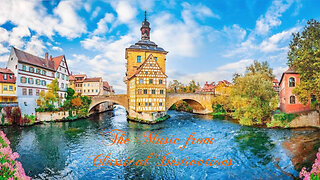Premium Only Content

Musei: Series I | Palazzo della Pilotta (Episode 8)
Episode 8: The Palazzo della Pilotta is a vaste complex of edifices located between Piazzale della Pace and the Lungoparma in the historical centre of Parma, region of Emilia Romagna, Italy. Its name derives from the game of pelota played at one time by Spanish soldiers stationed in Parma.
La Pilotta, an imposing palace symbol of the Farnese ducal power, historical and civil center of the city of Parma, is today a unique monumental complex. Originally conceived as a container for the services of the Farnesian court capable of integrating the system of ducal residences, the construction of the monumental Palazzo della Pilotta probably began around 1583, during the last years of the duchy of Ottavio Farnese (1547-1586) based on a project of Francesco Paciotto from Urbino.
The long corridors were arranged orthogonally to delimit a real "citadel", connected with the destroyed Ducal Palace and with that of the Garden, located on the other bank of the Parma Torrent. Its system of internal courtyards and the rustic brick wall were intended to contain warehouses, stables, barracks, as well as a grandiose armory room later transformed into a court theatre. The complex derives its name from the noble game of "pelota" which was played in its courtyards on special occasions of representation. Already home to a selected ducal picture gallery and a book collection in the Farnesian era, the Pilotta, during the duchy of Don Filippo di Borbone (1748-1765), hosted the Academy of Fine Arts with its artistic collection, from which it would then have originates the National Gallery, the Palatine Library, the Archaeological Museum and the Bodonian Museum.
The existing complex includes three courts: the Cortile di San Pietro Martire (now best known as Cortile della Pilotta), Cortile del Guazzatoio (originally della pelota) and the Cortile della Racchetta. The Pilotta was to house a large hall, later turned into the Teatro Farnese, the stables and the grooms' residences, the Academy Hall and other rooms. After the end of the Farnese family rule of Parma, much of the movable assets of the palace were removed by then Duke Charles I, later King of Spain, and taken to Naples in the 1730s. The Biblioteca Palatina was established here by 1769. Elizabeth Farnese, Queen of Spain, was born here in 1692.
By 2015, the building spaces had been taken up by a number of cultural institutions and museums, including in addition to the library:
- National Archaeological Museum
- Liceo artistico statale Paolo Toschi (an art school named after Paolo Toschi)
- Museo Bodoniano (a museum dedicated to Giambattista Bodoni)
- Teatro Farnese
- Galleria Nazionale di Parma
-
 38:46
38:46
Adaneth - Arts & Literature
2 days agoMusic from Classical Destinations
15 -
 2:28:32
2:28:32
MattMorseTV
4 hours ago $14.46 earned🔴Revealing his TRUE MOTIVES.🔴
24.9K120 -
 1:18:02
1:18:02
iCkEdMeL
2 hours ago $3.83 earnedBOMBSHELL: Shooter’s Trans Partner Helped Take Him Down
9.75K30 -
 1:42:45
1:42:45
The Big Mig™
7 hours agoThe Islamic Invasion – The EU Has Fallen, A Warning For The USA |EP653
20.3K31 -
 LIVE
LIVE
Joker Effect
2 hours agoRUMBLE IN THE DEN 4 - Hungry fighters and NFL legend fight for respect
536 watching -
 44:37
44:37
Rebel News
3 hours ago🔴 LIVE NOW: Massive ‘Unite the Kingdom’ Rally in London ft. Tommy Robinson | UKrebels.com
26.2K42 -
 17:22
17:22
Professor Nez
3 hours ago💣BOMBSHELL: The Biden AutoPen Scandal JUST GOT REAL!
13.6K16 -
 2:20:03
2:20:03
I_Came_With_Fire_Podcast
11 hours agoRevelations from the Ukrainian Front Lines
27.5K11 -
 52:56
52:56
X22 Report
7 hours agoMr & Mrs X - Big Pharma Vaccine/Drug Agenda Is Being Exposed To The People - Ep 7
85.3K55 -
 1:41:59
1:41:59
THE Bitcoin Podcast with Walker America
12 hours ago $18.34 earnedThe Assassination of Charlie Kirk | Walker America, American Hodl, Erik Cason, Guy Swann
69K45